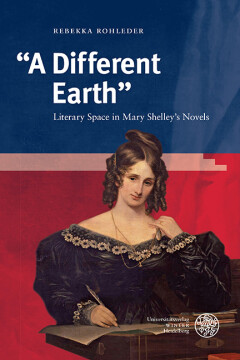
BUCH
“A Different Earth”
Literary Space in Mary Shelley’s Novels
Britannica et Americana. 3. Folge, Bd. 34
2019
Zusätzliche Informationen
Bibliografische Daten
Abstract
Inspired by the “spatial turn,” this book takes a fresh look at three of Mary Shelley’s novels: ‘Frankenstein’, ‘The Last Man’, and ‘Lodore’. It examines the literary and social spaces constructed in these three novels. The novels complement each other in the way in which the interaction between text and space is played through in each of them. In all three, however, space emerges as a socially and politically powerful construct, and the literary text itself is seen to play an important role in its construction. The three novels also implicitly reflect on their own role in this process. In this way, Shelley makes the naturalising logic of the spatial imagination visible, and challenges this logic in the process. Thus, the focus on literary space opens up an interesting perspective from which Shelley’s political and aesthetic concerns can be re-examined.
Inhaltsverzeichnis
| Zwischenüberschrift | Seite | Aktion | Preis |
|---|---|---|---|
| Cover | Umschlag | ||
| Titel | 3 | ||
| Imprint | 4 | ||
| Table of Contents | 5 | ||
| Acknowledgments | 7 | ||
| Introduction: “Hedged-in cornfields and measured hills | 9 | ||
| 1 “No monument”: Romanticism, Literature and Space | 17 | ||
| 1.1 Literary Space and the Spatial Turn | 19 | ||
| 1.1.1 Spatial turn, topographical turn, topological turn | 19 | ||
| 1.1.2 Literary Space | 31 | ||
| 1.2 “Reserved for the royal possessor”: Literary Space and/as Social Space | 38 | ||
| 1.2.1 Reading Social Space | 40 | ||
| 1.2.2 Performing Literary Space | 45 | ||
| 1.3 “The offspring of art, the nursling of nature”: Mary Shelley and the History of Space | 47 | ||
| 1.3.1 Histories of Space | 48 | ||
| 1.3.2 Reading Romantic Literary Space | 54 | ||
| 2 „The Last Man“ and “the order of the systematic world | 67 | ||
| 2.1 “On the giddy height” | 69 | ||
| 2.1.1 Living Maps | 71 | ||
| 2.1.2 Writing in Windsor | 82 | ||
| 2.1.3 “Seeing a battle” | 87 | ||
| 2.2 “The question of contagion” | 94 | ||
| 2.2.1 Reading the Plague | 95 | ||
| 2.2.2 Geographies of Disease | 99 | ||
| 2.2.3 Lost Spaces | 110 | ||
| 2.3 Cities of the Plague | 116 | ||
| 2.3.1 Constantinople/Stamboul | 117 | ||
| 2.3.2 Rome: Visiting “the scene which they beheld” | 127 | ||
| 2.3.3 Fanatics in Paris, Ghosts in Versailles | 134 | ||
| 2.3.4 London, “sufficiently changed” | 140 | ||
| 3 “A race of devils would be propagated upon the earth”: „Frankenstein“, Imaginary Populations, and Imaginary Spaces | 149 | ||
| 3.1 “A world already possessed”: Naturalising Poverty | 154 | ||
| 3.1.1 Spaces of Perfectibility | 154 | ||
| 3.1.2 Anti-Utopian Islands | 157 | ||
| 3.2 “The production of men”: From Thought Experiment to Fiction | 160 | ||
| 3.2.1 „The Last Man“: Imagining a Depopulated Earth | 162 | ||
| 3.2.2 The 1831 „Frankenstein“ and the Children of the Poor | 167 | ||
| 3.3 “Remember Utopia!” Gothic Imaginary Spaces in the 1818 „Frankenstein“ | 174 | ||
| 3.3.1 Hidden Spaces | 174 | ||
| 3.3.2 Spaces of Pursuit | 179 | ||
| 3.4 “The encroachment of the polar ice”: Resisting the Naturalisation Effect | 184 | ||
| 3.4.1 Imagining the Arctic | 187 | ||
| 3.4.2 Mutability | 198 | ||
| 4 „Lodore“: Making the Best of the Conventionalities | 203 | ||
| 4.1 “A bird of beauty, brooding in its own fair nest” | 210 | ||
| 4.1.1 Travelling | 214 | ||
| 4.1.2 Cottage, Garden, Study | 219 | ||
| 4.1.3 Drawing, Furnishing, Acting | 229 | ||
| 4.2 “Indeed, in England or America, she lived in a desart” | 235 | ||
| 4.2.1 “The ‘falls’ of Lodore” | 237 | ||
| 4.2.2 On the Impossibility of Travelling from Italy to England | 245 | ||
| 4.2.3 The City as Theatre | 252 | ||
| Conclusion: “Yet is it true that we do not believe in ghosts?” | 261 | ||
| Bibliography | 267 | ||
| Backcover | 285 |


 Powered by CloudPublish
Powered by CloudPublish